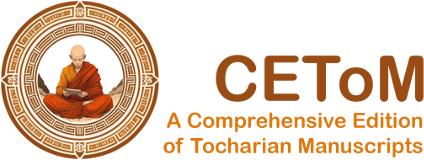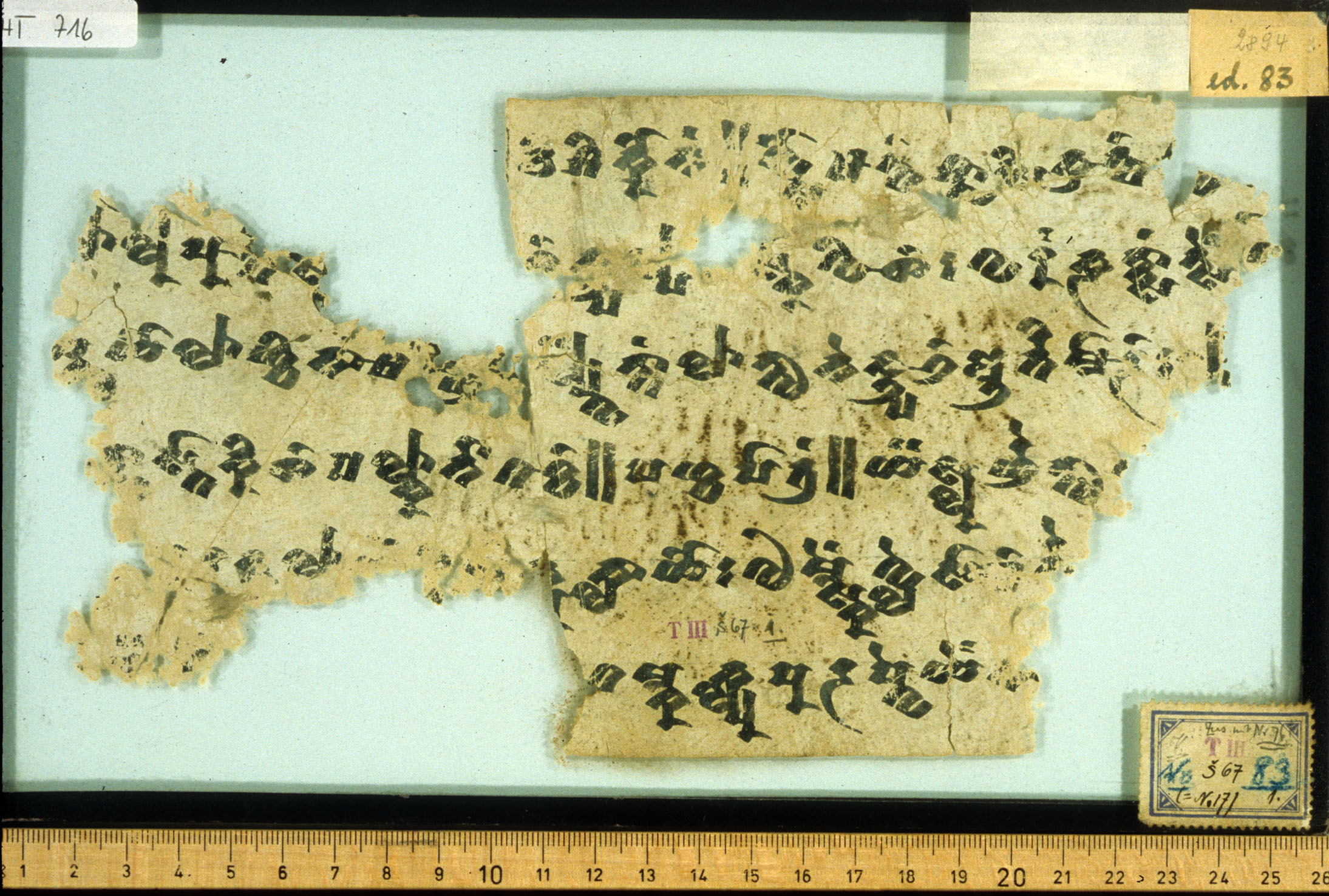A 76 and 83
| Known as: | A 76 and 83; A 76 = THT 709; A 83 = THT 716 |
|---|---|
| Cite this page as: | Gerd Carling. "A 76 and 83". In A Comprehensive Edition of Tocharian Manuscripts (CEToM). Created and maintained by Melanie Malzahn, Martin Braun, Hannes A. Fellner, and Bernhard Koller. https://cetom.univie.ac.at/?m-a76 (accessed 01 Jul. 2025). |
Edition | |
| Editor: | Gerd Carling |
Provenience | |
| Main find spot: | Shorchuk |
| Specific find spot: | Stadthöhle |
| Expedition code: | T III Š 68.11, T III Š 67.01 |
| Collection: | Berlin Turfan Collection |
Language and Script | |
| Language: | TA |
| Script: | late |
Text contents | |
| Title of the work: | Mūghapakkha-Jātaka |
| Passage: | d |
| Text genre: | Literary |
| Text subgenre: | Jātaka/Avadāna |
| Verse/Prose: | prose; verse |
| Meter: | 43434 (4x); 4343 (4x) |
Object | |
| Manuscript: | A 55-88 |
| Preceding fragment: | A 73 |
| Following fragment: | A 84 |
| Material: | ink on paper |
| Form: | Poṭhī |
| Number of lines: | 6 |
Images
Images from idp.bbaw.de by courtesy of the International Dunhuang Project Berlin, the Berlin-Brandenburgische Akademie der Wissenschaften, and the Staatsbibliothek zu Berlin – Orientabteilung.
Transliteration
(continues from A 73)
| a1 | /// || vi śi kko naṃ || wso ma¯ ¯nt śwā tsi kra¯ ¯nt /// /// [ka] śśi pe nu śo¯ ¯l ku lypa¯ ¯m kuya¯ (–) |
|---|---|
| a2 | /// lā lu pu¯ ¯nt tsra – – – [¯k] kuya lpa – sk[ā] wi¯ ¯s̝ : wa raṃ kra ntsāṃ tseṃ /// /// ppa¯ ¯l ā rṣlu mi nāṃ śo lku lypa¯ |
| a3 | /// yntu yo lā ñci nā¯ ¯s [ṣ]ñi [ma] lywä ntāṃ lā ntu ne kuya¯ ¯l ā rti mā¯ ¯r : 1 || /// /// ¯k śkaṃ pā ca rke nu t·· ka rsā ma¯ |
| a4 | /// t· ā stā ki¯ ¯s̝ pa lkā rnā ta¯ ¯k || pa ñca pā traṃ || yä slu rñe ntu /// /// s[a]¯ ¯nt pe nu lā ñci nā¯ ¯ñä |
| a5 | /// t·· lā [ñcä] [śśi] [mā] [kpu] klā yo : o mskeṃ wle sā[¯] [¯m] r[s]e /// /// wi [y]o ntā – wla llyāṃ |
| a6 | /// ta mka klyu ṣu ra ṣwe yeṃ nā /// /// [se] [n]tu pu klā yo |
| b1 | /// [s̝]ta mtu yne śmā pa lko na¯ – /// /// n[a] sl[u] ne yā śā sta |
| b2 | /// lko na¯ ¯s̝t ta – – – knā na¯ ¯t ta nne ti ryā lā ntu /// /// – ska ta¯ ¯r m[n]u lya lyu |
| b3 | /// nā ta¯ ¯k lā ñcä śśi yā mlu ne yaṃ yne śiṃ knā nmu ne ta myo /// /// ltra ṅka ṣpeṃ peṃ se ma¯ |
| b4 | /// – mlu ne yne¯ ¯śä knā na¯ ¯t || ma śki ttra ṅka s̝pa klyo ṣpā ca rma tne wra so[¯] [¯m] /// /// sneṃ ā lā lyciṃ y[n]e śpa lko |
| b5 | /// jā ti sma ru – – – – – ¯s cmo l· o pyā cka llā mā¯ ¯r || ya śo /// /// ·[u] vi lā paṃ || na ṣne¯ ¯s̝ cmo lw· |
| b6 | /// e ntse ype yu yśe ya tsi : o¯ ¯ṅk ma¯ ¯ṅk ·ā /// /// ·ts[ā] tṣa kka tse¯ ¯k ko ṣtlu ne ṣiṃ |
(continues on A 84)
Transcription
(continues from A 73)
| a1 | n1 /// ॥ viśikkonaṃ ॥ |
|---|
| 1a | wsomänt śwātsi ; krant /// 2σ ; /// kaśśi penu ; śol kulypam ; kuya – a2 3σ |
|---|---|
| 1b | 8σ /// lālupunt ; tsrä – – – 2σ k ; kuyal pa – 0σ skāwiṣ : |
| 1c | waraṃ kräntsāṃ ; tseṃ /// 1σ /// ppal ; ārṣlumināṃ ; śol kulypaa3(m) ; 4σ |
| 1d | 2σ /// yntuyo ; lāñcinās ; ṣñi malywäntāṃ ; lāntune ; kuyal ārtimār : 1 ॥ |
| * | /// /// k śkaṃ pācar ke nu t·· ··kärsāmä° |
|---|---|
| a4 | n2 /// t· ās tākiṣ pälkār nātäk ॥ pañcapātraṃ ॥ |
| 1a | yäslurñentu ; /// 4σ /// sant penu ; lāñcināñ |
|---|---|
| 1b | a5 6σ /// t·· 1σ ; lāñcäśśi māk ; puklāyo : |
| 1c | omskeṃ wlesām ; rse /// 3σ /// wiyontā – 0σ ; wlal lyāṃ a6 1σ |
| * | /// täm kaklyuṣuräṣ weyeṃ nā /// /// sentu puklāyo |
|---|---|
| b1 | /// ṣ täm tu yneś mā pälko na(ṣt) /// /// nasluneyā śāstä |
| b2 | /// lko naṣt tä – – – knānat tanne tiryā lāntu /// /// (mä)skatär mnu lyalyu |
| b3 | /// nātäk lāñcäśśi yāmluneyaṃ yneśiṃ knānmune tämyo /// /// l träṅkäṣ peṃ peṃ se mä° |
| b4 | n3 /// (yā)mlune yneś knānat ॥ mäśkit träṅkäṣ päklyoṣ pācar mät ne wrasom /// /// sneṃ ālālyciṃ yneś pälko |
| b5 | n4 /// jātismaru – – – – – s cmol(u) opyāc källāmār ॥ yaśo /// /// ·uvilāpaṃ ॥ |
| 1a | näṣ neṣ cmolw· ; b6 10σ |
|---|---|
| 1b | 7σ /// ; entse ypeyu ; yśe yatsi : |
| 1c | oṅk maṅk ·ā /// /// ·tsāt ; ṣakk atsek ; koṣtluneṣiṃ ; |
(continues on A 84)
Translation
(continues from A 73)
| a1 | ... || In the V.-tune: || |
|---|---|
| a1+ | Should he (enjoy) a poisonous dish as good (food) ... who loves [his] life, why... |
| a2 | ... or why should one be fond of (?) a stained ... |
| a2+ | (how should) someone who wants to live, (yearn for [the smell of] a nice-smelling blue) lotus containing a snake |
| a3 | ... How should I love kingship, oppressing me with the royal ... 1. And also, father, how could someone who [is] knowledgeable in it, |
| a4 | ... or desirous be? See, oh lord: || In the P.-tune: || Hostilities [and] ... [are] also royal obligations |
| a5 | ... of the kings [for] many years. |
| a5+ | (And) evil [is] the obligation, to the one [who is] ... (by) hate confused, at the (time) of [his] death. |
| a6 | ... When he had heard this, (the king says) in bewilderment: ... |
| a6+ | (Oh lord,) my son! [For] years you (have (?))... |
| b1 | ... This you have not actually seen ... |
| b1+ | ... with regard to being a ruler (?) as a teacher |
| b2 | .. (This) you have (not really) seen. This you do (not) know. Kingship is (not) of such kind. |
| b3 | Excitedly (the prince says to the king:) Oh lord, in the doing of the kings (I do not see) the true knowledge of it [i.e. kingship]. ... The king says: Speak, speak, [my] son! |
| b4 | (In) what (way) do you really know the doing (of kings)? The prince says: Listen, father! |
| b4+ | Just like a human clearly seeing (one’s) ... shoulders without a callus ... (just so,) having the memory of the births, I remember [my] (previous) births. |
| b5 | || In the Y.- tune: || |
| b5+ | (In) earlier births I have... |
| b6 | ... resorted (to cruelty) in order to preserve the realms. A man (made) a mistake, ... certainly the (command (?)) to kill |
(continues on A 84)
Other
| a3 | Wie sollte ich die Königswürde lieben, die mich bedrückt durch die königlichen ... ? (Schmidt 1974: 169) |
|---|---|
| b5 | ... (genau so) erinnere ich mich, da ich die Erinnerung an die Geburten habe, der (früheren) Geburten. (Schmidt 1974: 375) |
Commentary
Remarks
| Transcription and references have been transferred from the "Text and Reference Database of the Tocharian A Language" (Gerd Carling Lund University) (funded by the Bank of Sweden Tercentenary Foundation and SCAS). | |
| Transcription and translation are based on Carling et al. 2009. | |
| A 76 (right hand side) and A 83 (middle part) belong to the same leaf, but do not immediately connect to each other. |
Philological commentary
| The translation is largely based on Sieg 1952: 20-21, and Carling et al. 2009. It is given for both fragments (A 83 and A 76) together here, separated by a slash (/). | |
| n1 | This tune has 4x18 syllables, rhythm 7/7/4. |
| n2 | This tune has 4x14 syllables, rhythm 7/7. |
| n4 | This tune (Yaśo(dha)ravilāpaṃ) has 4x18 syllables, rhythm 7/7/4. |
Linguistic commentary
| n3 | Couvreur 1954b: 260 has (e)sneṃ as adjective (“shoulder-”). |
|---|
References
Online access
Edition
Sieg and Siegling 1921: 45, 48-49; Sieg and Siegling 1921 p. 45, p. 49
Translations
Carling 2000: a5 (311); Knoll 1996: a5 (34), a6 (45); Kölver 1965: a6 (104), b3 (129); Schmidt 1974: a3 (169), b5 (375), b5 b6 (375); Sieg 1952: a1 a2 a3 a4 a5 a6 b1 b2 b3 b4 b5 b6 (20-21); Thomas 1954: b5 b6 (715); Thomas 1957: b1 (247), b2 (247), b4 (272f); Thomas 1968: b4 (224)
Bibliography
Carling, Gerd. 2000. Die Funktion der lokalen Kasus im Tocharischen. Berlin/New York: de Gruyter.
Carling, Gerd, Georges-Jean Pinault, and Werner Winter. 2009. A dictionary and thesaurus of Tocharian A. Volume 1: Letters a-j. Wiesbaden: Harrassowitz.
Couvreur, Walter. 1954b. “Review of: Übersetzungen aus dem Tocharischen II, aus dem Nachlass hg. v. Werner Thomas.” Orientalische Literaturzeitung 5/6: 259–61.
“The International Dunhuang Project: The Silk Road Online.” n.d. http://idp.bl.uk.
Knoll, Gabriele. 1996. “Die Verwendungsweisen der Adjektive im Tocharischen.” PhD, Universität Frankfurt am Main.
Kölver, Bernhard. 1965. “Der Gebrauch der sekundären Kasus im Tocharischen.” PhD, Universität Frankfurt am Main.
Schmidt, Klaus T. 1974. “Die Gebrauchsweisen des Mediums im Tocharischen.” PhD, Universität Göttingen.
Sieg, Emil. 1952. Übersetzungen aus dem Tocharischen II, aus dem Nachlass hg. v. Werner Thomas. Abhandl. d. Deutschen Akad. d. Wissenschaften zu Berlin, Kl. f. Sprachen, Literatur und Kunst 1. Berlin: Akademie-Verlag.
Sieg, Emil, and Wilhelm Siegling. 1921. Tocharische Sprachreste, I. Band. Die Texte. A. Transcription. Berlin/Leipzig: de Gruyter.
Sieg, Emil, and Wilhelm Siegling. 1921. Tocharische Sprachreste, I. Band. Die Texte. A. Transcription. Personal annotated copy of Wilhelm Siegling. Scanned by Douglas Q. Adams with the technical assistance of Michael Tarabulski and Kevin Dobbins. Berlin/Leipzig: de Gruyter.
Thomas, Werner. 1954. “Die Infinitive im Tocharischen.” In Asiatica. Festschrift Friedrich Weller. Zum 65. Geburtstag, gewidmet von seinen Freunden, Kollegen und Schülern, edited by Johannes Schubert and Ulrich Schneider, 701–64. Leipzig: Harrassowitz.
Thomas, Werner. 1957. Der Gebrauch der Vergangenheitstempora im Tocharischen. Wiesbaden: Harrassowitz.
Thomas, Werner. 1968. “Zur Verwendung von toch. A oki/B ramt und A mäṃtne/B mäkte in Vergleichen.” Orbis 17: 198–231.
Gippert, Jost, Katharina Kupfer, Christiane Schaefer, and Tatsushi Tamai. n.d. “Thesaurus Indogermanischer Text- und Sprachmaterialien (TITUS): Tocharian Manuscripts from the Berlin Turfan Collection.” http://titus.fkidg1.uni-frankfurt.de/texte/tocharic/thtframe.htm.






